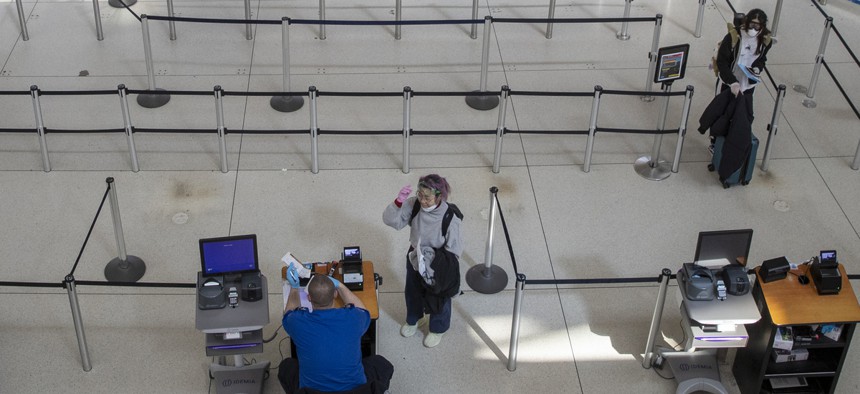Airports Start Requiring Masks for All Travelers and Staff

An empty security line at JFK airport in New York. AP Photo/Mary Altaffer
The measure is one of many changes airports are making in hopes of improving safety.
Airports across the country are beginning to require all travelers and staff wear masks in hopes that the mandates will slow the spread of coronavirus.
The Transportation Security Administration is currently considering a blanket face coverings requirement for all passengers who pass through TSA checkpoints, but has not yet taken that step. In the meantime, cities are taking the lead.
Denver was one of the first to implement the new measures on Wednesday as part of a broader city mandate requiring residents to cover their mouths any time they go out in public. Travelers to Denver International Airport will find masks are just one of many changes forced by the coronavirus pandemic. The airport is now equipped with over 100 hand sanitizing stations, plexiglass screens at TSA podium checkpoints, and wipe dispensers at each gate so that passengers can disinfect their seat and tray after boarding.
Denver, like many cities, is trying a compliance model that first emphasizes education with the new mask requirement, although those who refuse to cover their mouth at the airport could face a fine up to $999.
Denver’s steps to combat the spread of the virus mirror those taken by other cities with major airports across the country in the past few days. Although U.S. air travel has dropped by 95% percent and planes are averaging about 17 passengers per flight, there are still roughly 120,000 people jetting off every day, with numbers showing a gradual uptick in recent days as the pandemic drags on.
Major airports in California, including those in San Diego, Oakland, San Francisco, and Los Angeles, have either already implemented a face mask requirement or will soon. Starting on May 11, travelers at Los Angeles International Airport will be required to wear masks, a measure that Mayor Eric Garcetti said should come as no surprise. “The new requirement aligns with what many airlines are doing as well,” Garcetti said on Wednesday. “Right now many airlines require the passengers and flight crews to wear face coverings on flights, and these are steps that will help us all be safe.”
JetBlue was the first airline to require that all passengers cover their faces starting May 4. Joanna Geraghty, the company’s president, said that while “cabin air is well circulated,” the plane is still “a shared space” where passengers must be considerate of others. “Wearing a face covering isn’t about protecting yourself, it’s about protecting those around you,” she said in a statement. “This is the new flying etiquette.”
The step was praised by those in the airline industry who have been pushing for such measures, including the Association of Flight Attendants, and was followed by similar announcements from American, Delta, United, Southwest, Frontier, and Alaska Airlines, although not all rules are yet in effect.
Other airport industry unions are similarly trying to apply pressure on decision makers to implement stronger protections for workers. At least 505 TSA employees have confirmed cases of the virus nationwide, and the American Federation of Government Employees, which represents nearly 46,000 TSA officers, is calling for more action to be taken to ensure their safety. On Wednesday, TSA announced that they would require all security officers to wear masks in screening areas, but AFGE counters that there is still more that can be done, including the agency providing hazard pay and a requirement that all passengers wear masks, regardless of what airport they are departing from.
AFGE President Everett Kelley said in a statement that TSA must implement changes or else face an even greater number of cases among staff members. “We’ve heard concerns from transportation security officers that many passengers coming through the security line are still not wearing masks,” he said. “This will become an even greater problem when higher travel volume resumes.”
When, exactly, that higher travel volume will resume is still a point of uncertainty. Airlines seem to be anticipating that a return to normal won’t happen for many months and are preparing for a dearth of passengers well into the fall—or beyond then. The U.S. Department of Transportation has already given permission to JetBlue and Spirit Airlines to suspend service at certain airports after the companies reported that some routes had just two passengers per plane.
It’s possible that air travel could become more normalized if measures employed in airports in other countries arrive in the U.S. In Dubai, some airlines are piloting rapid result blood tests for passengers before boarding, while in Vienna disembarking passengers have the opportunity to take a regular Covid-19 test. Negative test results allow travelers to receive a certificate that lets them avoid the 14-day quarantine imposed on visitors.
For now, though, airline and flight staff are begging passengers to follow the strictest possible rules, even if their local airport isn’t requiring masks. Sara Nelson, president of the Association of Flight Attendants, said in a statement that doing so will help save lives. “From the airport door to the door on the airplane, and then back out through the airport, we want people wearing face coverings in all those areas,” she said.
Emma Coleman is the assistant editor for Route Fifty.
NEXT STORY: IT responders keep government at work






